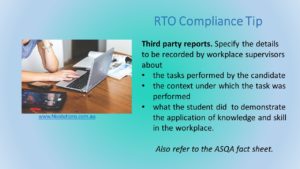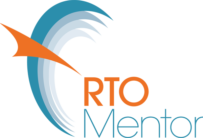RTO evidence gathering comes in many shapes and forms. The third-party reports in this post is not where you need a contract with someone else. It is as simple as having someone in the workplace gather some of your evidence.
When developing assessment evidence within your RTO to be collected it usually falls into three broad categories:
- direct evidence: evidence the assessor observes first-hand (e.g. workplace demonstration, work sample, questioning the applicant)
- indirect evidence: evidence reported by someone else (e.g. third party report, workplace performance review)
- supplementary evidence: any other evidence that can indicate performance (e.g. training records, written work, portfolios)
The tips today are about the third‑party evidence that is collected from workplace supervisors, peers and others to support an assessment decision. 
When collecting RTO evidence from employers or other parties we often call them Third Party Reports, or Supervisor Reports. This Third Party report is where a person contributes evidence of competency, e.g. in the case of workplace supervisors in traineeship or apprenticeship arrangements. Remember the evidence of the third party report is not to be used as a standalone. It needs to be supported with other evidence, such as assessor observations, questions, projects etc.
Reports
These reports often include an observation of the learners undertaking regular workplace tasks. Make sure you include enough information in this report that provides sufficient details of the tasks being completed. Include the date the observation took place, any behaviour requirements, and allow for feedback from the 3rd party.
Now it is your role, as an RTO, or Assessor, to decide on what the evidence collected from this person will look like.
Considerations
There are several things to consider when preparing guidelines for gathering third‑party evidence to ensure the evidence collected meets the rules of evidence:
- a decision needs to be made about the appropriate balance between third‑party evidence and evidence drawn from other sources
- the evidence presented demonstrates the learner has the skills, knowledge and attributes as described in the unit of competency and assessment requirements
- does the writer of the report need to have any specific qualifications or vocational competencies such as a TAE
- the required experience of the third‑party evidence gatherer
- the third-party is not making a decision about the student’s competence
- the evidence is presented in written/official form, includes the name and contact details of the third-party and can be easily verified
The best advice is to undertake a validation process before it is used and then following the collection of evidence. We suggest you nominate a period of time and then validate. This process will ensure it is practicable and you are getting the right evidence to support the student….if not, make a change, and record in your continuous improvement process.
Remember to refer to the ASQA fact sheet
RTO Mentor is available to assist and / support you with your RTO systems, meeting Trainer and Assessor competencies and assessment processes. An RTO Internal Audit can review your documentation and prepare you for any pending audits.
We find that when someone has an outside view on your processes and tools they can see things that people within the organisation often miss.
Enjoy!
Are your reports compliant?
Contact Merinda to do an internal audit
